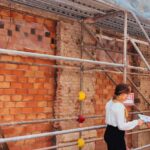
Building a new house is a significant undertaking, and it comes with numerous benefits beyond just having a place to call your own. For those considering constructing a home in Chandigarh, it’s crucial to weigh the advantages and understand the construction costs per square foot. In this blog, we’ll explore the benefits of building a new house and delve into the key factors influencing construction costs, focusing on finding the right architectural firm in Chandigarh to guide you through the process.
Benefits of Building a New House with the Right Architectural Firm in Chandigarh

Building a new house is a significant life decision, and it comes with numerous advantages, especially when you collaborate with an experienced architectural firm in Chandigarh. From customization to energy efficiency and long-term cost savings, constructing a new home offers a range of benefits that can enhance your quality of life and provide a secure investment for the future. In this article, we’ll delve into the key advantages of building a new house, emphasizing the role of the right architectural firm in Chandigarh in realizing your dream home.
Customization and Personalization
One of the most significant advantages of building a new house is the ability to tailor every aspect to your preferences and needs. When you work with a reputable architectural firm in Chandigarh, you can design your dream home from the ground up. This includes choosing the layout, materials, finishes, and fixtures that align perfectly with your vision.
Whether you desire an open-concept living space, a spacious kitchen, a dedicated home office, or a luxurious master suite, building a new house allows you to turn your ideas into reality. You can create a space that reflects your lifestyle, ensuring that every room serves a meaningful purpose to you and your family.
Energy Efficiency and Sustainability

Modern construction techniques and materials have made new homes more energy-efficient and environmentally friendly than older properties. Today, energy-efficient designs and sustainable building practices are at the forefront of new house construction.
When you partner with an architectural firm in Chandigarh that prioritizes sustainability, you can incorporate features such as improved insulation, energy-efficient windows, solar panels, and high-efficiency heating and cooling systems. These elements not only reduce your home’s environmental footprint but also lead to long-term cost savings through lower utility bills.
Quality Assurance
Building a new house ensures that you have control over the quality of construction. You can select high-quality materials and oversee the construction process to ensure that your home is built to the highest standards. This level of oversight and quality control is challenging to achieve with older properties, which may have hidden issues and maintenance concerns.
By collaborating with a reputable architectural firm in Chandigarh, you can trust that your new home will be constructed with precision and attention to detail, resulting in a durable and aesthetically pleasing residence.
Low Maintenance Requirements
Newly constructed homes typically require fewer immediate repairs and maintenance tasks compared to older properties. With modern materials and construction techniques, you can enjoy a home that is designed to withstand the test of time.
This translates into reduced maintenance costs in the early years of homeownership, allowing you to focus your resources on personalizing your new space and making it truly your own.
Safety and Compliance

Building codes and safety regulations evolve over time to address new technologies and safety standards. When you build a new house, you can be confident that your home complies with the latest safety codes and regulations. This not only ensures the safety of your family but also minimizes the risk of costly retrofits or updates in the future.
A reputable architectural developer will deeply understand local building codes and regulations, ensuring that your new home meets all the requirements.
Understand the Construction Costs per Square Foot.
When embarking on a construction project, whether it’s a residential home, commercial building, or infrastructure development, comprehending construction costs per square foot is paramount. Engineering consultancy services play a vital role in helping clients navigate these costs efficiently. Let’s delve into the concept of construction costs per square foot, its components, and how to manage and optimize these costs.
What are Construction Costs per Square Foot?

Construction costs per square foot, often abbreviated as “cost/sq.ft,” is a fundamental metric used in the construction industry to estimate and compare the cost of construction projects. It represents the total cost of constructing a building or structure per square foot of its total floor area. This metric is valuable for budgeting, cost analysis, and project feasibility assessments.
Components of Construction Costs per Square Foot
Material Costs
Material costs encompass the expenses related to the construction materials used in the project. This category includes a wide range of materials, such as concrete, steel, lumber, roofing materials, insulation, drywall, flooring, tiles, and paint. Material costs can vary significantly based on factors like material type, quality, quantity, and market fluctuations.
Labor Costs
Labor costs encompass wages, salaries, and benefits for the labor force engaged in the construction project. This includes skilled tradespeople, construction workers, contractors, subcontractors, and any specialized labor required for the project. Labor costs are influenced by factors such as labor availability, skill level, and regional wage rates.
Site Preparation Costs
Site preparation costs cover expenses associated with getting the construction site ready for building. This includes activities like site clearing, excavation, grading, soil testing, and the installation of foundations. The nature and condition of the site can significantly impact these costs.
Utilities and Infrastructure Costs
Utilities and infrastructure costs involve the expenses of providing essential services to the building, such as water supply, electrical connections, sewage systems, and telecommunications infrastructure. These costs can vary depending on the area’s existing infrastructure and the project’s requirements.
Permits and Regulatory Costs
Construction projects often require permits and approvals to ensure compliance with local building codes and regulations. Permit and regulatory costs cover the expenses of obtaining the necessary permits, inspections, and approvals from local authorities. Compliance costs can vary based on the complexity of the project and the specific requirements of the jurisdiction.
Architectural and Engineering Fees
Architectural and engineering fees include payments made to architectural and engineering firms for their design and planning services. These professionals are responsible for creating the project’s blueprint structural plans and ensuring that the construction adheres to safety and quality standards.
Overhead and Contingency
Overhead costs include general project overhead expenses, such as project management fees, insurance, administrative costs, and office rent. Contingency costs are set aside to address unforeseen issues or changes during construction. These funds act as a buffer to cover unexpected expenses and ensure the project remains on track.
Finishing and Interior Costs
Finishing and interior costs encompass expenses related to the interior of the building. This includes fixtures, lighting, HVAC systems, plumbing, electrical work, flooring, wall finishes, cabinetry, and any other interior components. The choice of materials and finishes can significantly impact these costs.
Legal and Financing Costs
Legal and financing costs encompass expenses associated with legal matters, including contract negotiations, permits, and financing. Financing costs may include interest on loans, loan origination fees, and other financial charges related to project funding.
Land and Site Acquisition Costs
Land and site acquisition costs cover expenses related to acquiring property for construction projects. This includes the purchase price of the land, property surveys, legal fees, title searches, and any other costs associated with securing the site for development.
Understanding these components of construction costs per square foot is essential for project planning, budgeting, and cost management. Accurate cost estimates and effective allocation of resources are critical for ensuring that construction projects are completed successfully, on time, and within budget.
Choosing the Right Architectural Firm in Chandigarh

Selecting the right architectural firm in Chandigarh is a critical step in ensuring the success of your construction or renovation project. Whether you’re planning a residential, commercial, or industrial development, the expertise and capabilities of your architectural partner can significantly influence the project’s outcome. Here are key considerations to guide you in making an informed choice
Experience and Portfolio
Begin your search by assessing the architectural firm’s experience and portfolio. Look for a firm with a diverse range of projects that align with your specific requirements. Experience in similar projects can be a valuable asset, as it ensures the firm understands your project type’s unique challenges and opportunities.
Reputation and References
A reputable architectural firm will have a positive reputation in the industry and among clients. Seek references and read client testimonials or reviews to gain insights into their track record. An architectural firm in Chandigarh with a strong reputation is more likely to deliver high-quality results and a positive working relationship.
Licensing and Credentials
Ensure that the architectural firm and its architects are licensed and accredited by relevant professional organizations. This ensures that they meet the necessary standards for competence and ethical conduct. It’s also crucial to verify that they are up-to-date with local building codes and regulations in Chandigarh.
Design Style and Compatibility
Consider the design style and approach of the architectural firm. Review their previous projects to see if their design sensibilities align with your vision. A harmonious design philosophy between you and the firm will lead to a more successful collaboration.
Communication and Collaboration
Effective communication is key to a successful partnership with an architectural firm. Ensure that the firm values your input and actively involves you in the design and decision-making process. Collaborative architects can better understand your needs and preferences.
Project Size and Scale
Evaluate whether the architectural firm in Chandigarh has experience handling projects of your desired size and scale. Whether it’s a small renovation or a large commercial development, their ability to manage the project effectively is crucial.
Sustainable Design and Innovation
If sustainability is a priority for your project, inquire about the firm’s expertise in sustainable and green building practices. Architects well-versed in sustainable design can help you minimize environmental impact and reduce long-term operational costs.
Budget Alignment
Discuss your budget openly with the architectural firm and ensure they can work within your financial constraints while maintaining design quality. Transparency about fees and costs is essential.
Project Timeline and Deadlines
Clarify the firm’s approach to project timelines and deadlines. A well-structured timeline ensures that your project progresses smoothly and is completed on schedule.
Compatibility and Trust
Ultimately, trust your instincts when choosing an architectural firm. A strong working relationship built on trust and open communication is essential for a successful partnership.
In the dynamic architectural landscape, selecting the right architectural firm in Chandigarh can make all the difference in achieving your project’s goals and vision. Take your time to research, interview potential firms, and ask probing questions. Choosing an architectural firm that aligns with your needs and values sets the foundation for a successful, well-designed project that meets your objectives and stands the test of time.















0 Comments